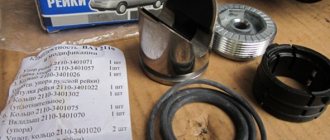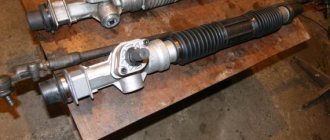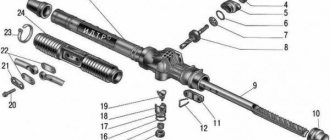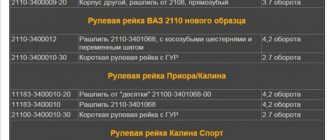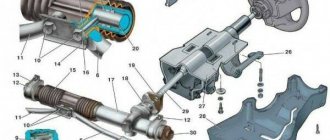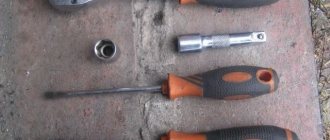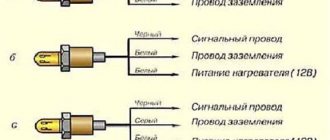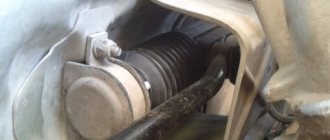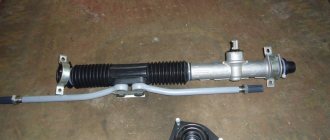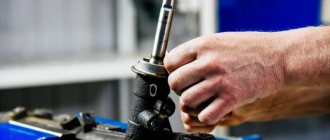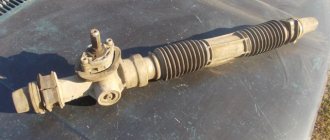I haven’t written anything for a long time, since I was busy with construction and during this time I did almost nothing with the car, I just changed the rear brake cylinder and the handbrake cable, otherwise it completely soured and the handbrake disappeared no matter how hard I pulled it. The driveshaft has been rattling for a long time, but now the roar has become completely unbearable, and even the steering play has become like that of a Kamaz. I decided to change to a solid one from TAYA (Technology from A to Z)
and not because it’s super duper, but since I didn’t turn the original one, there was still some play in the connection of the two halves of the original one. I set the steering wheel straight, made marks on the rack and the steering wheel,
I separated the two halves of the original, to do this I unscrewed the bolt that held them and hit them with a hammer until they separated and removed them separately from each other.
Then I removed all the plastic around the steering shaft from the EUR,
then I loosened the fastenings of the steering shaft, did not remove it, but only moved it up, this was praised,
in order to put the new one in place, I moved the clamping parts of the shaft a little to the sides, to do this I inserted a chisel and hit it a couple of times,
and put it in place without any problems, but turning the bolts turned out to be problematic, I had to tighten it with a clamp from the side of the steering rack and then the bolt would turn,
but on the other hand it was not possible to crawl up with a clamp, I had to drill a hole from the side where the thread was
and insert a bolt with a nut from the old cardan (there they are with nuts, but in the new one the threads are cut into the body of the cardan and the bolts are without nuts).
I tightened everything up and put it in place and drove off. What can I say from the feeling, it’s just a thrill, there hasn’t been such silence in this part of the car for a long time, the steering has become very collected, bumps are not felt at all and steering has become much easier and softer, I’m very pleased with the work done. I don’t want to say that my native one was completely bad, but there was always a slight play in the connecting part, I even climbed into my father’s viburnum to check, he also had a play, but it didn’t rattle.
Removing the electric power steering column
We set the wheels to the position of straight-line movement of the car.
Disconnect the wire terminal from the negative terminal of the battery. Remove the steering wheel (see “Removing the steering wheel”). We remove the steering column switches (see “Removing the steering column switches”). Disconnect the ignition switch wire connectors from the instrument panel wiring harness connectors. If necessary, remove the ignition switch from the steering column (see “Removing and disassembling the ignition switch”) Use a Phillips screwdriver to unscrew the three screws.
. and remove the lower cross member of the instrument panel.
By pressing the clamps, disconnect the two wiring harness blocks from the power steering control unit. Disconnect the wiring harness block from the connector of the steering column switches (see “Removing the steering column switches”).
Using a high “13” head, unscrew the four nuts securing the bracket (the fourth nut is not visible in the photo).
. and lower the column to the floor. If necessary, remove the connector for the steering column switches (see “Removing the steering column switches”).
Using a 13mm socket, unscrew the nut of the bolt securing the lower cardan joint to the steering gear shaft. If the bolt turns, hold it with a 13mm wrench.
Using a powerful slotted screwdriver, release the terminal connection of the hinge.
. and remove the intermediate propeller shaft from the steering gear shaft. Before disconnecting the intermediate propeller shaft from the steering shaft, use a marker to mark the relative position of the upper joint of the propeller shaft relative to the steering shaft.
Using a 13mm wrench, unscrew the nut of the hinge coupling bolt. If the bolt turns, hold it with a 13mm wrench. We take out the bolt
Use a screwdriver to loosen the terminal connection of the hinge.
. and remove the intermediate driveshaft from the steering shaft.
Intermediate cardan shaft
Install the intermediate driveshaft in reverse order. When connecting the upper joint of the intermediate propeller shaft to the steering shaft, it is necessary to align the previously made marks. Install the steering column in the reverse order. Installation this way is best done with an assistant. However, it is more convenient to install the column when the lower hinge of the intermediate propeller shaft is installed on the steering gear shaft in advance. To do this, after connecting the intermediate propeller shaft to the steering shaft...
. Using a 13mm wrench, unscrew the nut of the intermediate shaft coupling bolt. . remove the bolt.
. and disconnect the lower universal joint from the upper one. We install the lower hinge on the steering gear shaft (the bolt securing the hinge to the gear shaft should be located vertically on the right side). We turn the steering shaft so that the hole in the upper hinge for the intermediate shaft pinch bolt is located horizontally at the bottom of the shaft. We connect the upper and lower hinges of the intermediate shaft, insert the coupling bolt and tighten the nut. We carry out further installation in reverse order.
Diagnostics of the Kalina steering rack
So, dear readers, it is worth repairing the Kalina steering rack only if the right end of the rack is in perfect condition. If there is rust on it (as it was for me), then it will act as an abrasive and will “eat” the nylon bushing quite quickly. The right edge of the “rasp” should shine like a mirror, only then it will not break the sleeve.
Checking the condition of the right edge of the rail is quite simple. To do this, you need to carefully cut off the plastic clamp that secures the long right boot, then remove this boot and, turning the steering wheel to the left, visually inspect the right end of the rack that has emerged from the body.
I advise you to carry out such diagnostics before removing the rack from the car. And in general, if you are going to solve the problem with the rack yourself, then I sincerely wish you to remove and install it only once, because the process of installing the rack is quite complicated and can cause discomfort, especially if it needs to be repeated.
In the article about steering rack repair, I already mentioned how to determine that the knocking is coming from the Kalina steering rack . To do this, open the hood and give the steering rod a good tug with your hand . A serviceable steering rack bushing will not allow the rods to move even a millimeter, but with a “broken” bushing, the rods will shake.
At the beginning of this video you can clearly see the play of the steering rack after a run of 164 t.km, and at the end - a new steering rack after a run of 3 t.km.
As you can see, there is no play on the new rack. If on your Kalina do not dangle , it means that it is NOT the rack that is knocking .
Replacing the steering shaft in Lada Kalina
One of the largest Russian enterprises involved in the development of passenger cars is AvtoVAZ. During the period when AvtoVAZ existed, many cars have already been produced and released. One of the released models is the VAZ1118, and this is the very first version of the Lada Kalina. The first Lada Kalina model began production in 2004 and ended in 2011. Although the production of this car model ceased a couple of years ago, the car itself did not disappear from Russian roads and they are still found on the roads of many Russian cities.
Is it necessary to do a wheel alignment when replacing the steering rack?
In conclusion, I would like to discuss with you this question, which is probably asked by everyone who is going to replace or repair the steering rack: is it necessary to adjust the wheel alignment after repairing or replacing the steering rack? There is an opinion that this must be done; personally, I believe that the wheel alignment angles are NOT violated during such repairs , and therefore it is not necessary to adjust them . When replacing a steering rack, as well as when repairing it, the suspension geometry does not change in any way; the steering rods are unscrewed from the rack and then screwed back, while all dimensions remain the same.
It’s another matter if, when replacing the steering rack, you also change the steering rod assemblies or at least the steering ends . In this case, it is unlikely that you will be able to accurately adjust the length of the new steering rods, and therefore adjusting the wheel alignment angles is simply necessary .
In this article, we looked at the option of replacing the rack without tie rods and ends, and therefore the procedure for replacing Kalina’s tie rod ends will be discussed in a separate article.
Prototypes of “Lada Kalina”
Lada Kalina 1119 hatchback
The first generation of the Lada Kalina model is the Lada Kalina 1119 hatchback, produced from 2006 to 2013 inclusive. The presented Lada Kalina prototype, compared to the sedan and station wagon, has an insufficiently large trunk volume, but if you fold the rear seats, you can carry a fairly large load. There are three basic configurations of this model: luxury, normal and standard. The luxury package includes improved velor upholstery of door panels and seats.
The engine has an eight-valve engine with a volume of 1.6 liters and a modern sixteen-valve unit with a volume of 1.4 liters. Its production began in 2007.
Lighter pistons, cylinder heads, steel intake manifold gaskets and extended connecting rods were used here. Thanks to the modern engine, the Lada Kalina has become more dynamic.
Lada Kalina 1118 sedan
Since 2004, the Lada Kalina model with a sedan body began to be produced, and in 2011, production of the four-wheel drive car ceased. The wheelbase and spacious interior of the sedan are no different from the station wagon and hatchback, and in terms of luggage compartment volume the sedan ranks first. In 2007, the car model received an improved sixteen-valve engine with a lightweight connecting rod and piston group.
Steering shaft cardan Lada Kalina
Lada Kalina 1117 station wagon
Mass production of the station wagon began in 2007, and in 2009 the Lada Kalina was improved. The luggage compartment volume of a station wagon is larger compared to a hatchback and smaller compared to a sedan. The engine has an eight-valve engine with a volume of 1.6 liters and a modern sixteen-valve unit with a volume of 1.4 liters. Reducing engine displacement made the Lada Kalina much more economical and dynamic. There are three basic configurations of this model: luxury, normal and standard.
Steering shaft
The steering shaft provides the connection between the steering wheel and the steering mechanism. Quite often a joint steering shaft is used. Thanks to it, the level of driver injuries in the event of an emergency is reduced.
Positive qualities of the steering shaft:
- Silence. Due to the absence of play in the universal joint with elastic bushings, silent operation occurs;
- There is no jamming and ease of rotation is noticeable, thanks to the presence of high-quality lubrication and the high anti-friction properties of the cardan bushings;
- Excellent elasticity of the cardan bushings, and this guarantees long-term use.
Replace the lower steering shaft driveshaft
- Open-end wrench 12;
- Hammer;
- Ratchet wrench with heads 10 and 12;
- Chisel;
- A slotted screwdriver with a thick and wide blade;
- Mount.
So, how to change the steering shaft driveshaft on a Kalina?
To replace the Kalina steering shaft driveshaft, you need to follow these steps:
- Align the wheels in the direction of straight-line movement of the car;
- Remove the cover from the corrugated air filter;
- Unscrew the 12mm bolt at the pedal assemblies;
- Unscrew the 12mm bolt in the hood area;
- By tapping on the ears of the cardan with a hammer, it is necessary to knock the cardan towards the steering wheel;
- Remove the cardan from the rack shaft;
- Using a 10mm socket, unscrew the engine shield bolts and slide the casing up the cardan;
- Using a pry bar, push the cardan up along the shaft splines;
- Pull the driveshaft down and remove it from the steering shaft;
- Place the boot on the new cardan;
- Insert a new cardan through the engine shield casing into the passenger compartment;
- In the cabin, you should get the universal joint into the upper universal joint of the steering rack;
- Place the steering wheel straight and place the cardan on the rack shaft;
- Tighten the bolts.
We remove the knock of the steering shaft on Lada Granta, Kalina and Priora
We noticed that when driving on uneven roads (for example, gravel), vibration is strongly transmitted to the steering wheel.
It is also possible that a knock may occur, but it is not the steering rack that is rattling. The cause of the rattling may be play in the steering shaft. It is proposed to solve the problem with the help of a simple modification, which was used on VAZ 2108-15 cars. Knocking and rattling noises appear due to gaps in the mating parts. To eliminate them, insert a rubber cube (dimensions 22x22x22 mm) into the universal joint of the intermediate steering shaft. It is cut out from the rubber bumper of the rear suspension of the “classic”.
To install the rubber part into the steering shaft, you don’t need to remove anything, just crawl under the panel and look for the connection above the brake pedal. To fit the cube into a narrow space, you will need to lubricate it (for example, WD-40) and use a clamp or jack.
For owners of Lada Granta and Kalina models with ESD, there is an alternative to this modification - install a steering driveshaft without knocking (catalog numbers: 11186-3422092-00, 21230-3401085-00). Let us remind you that in some cases the causes of knocking can be eliminated by tightening the steering rack or steering shaft bolt. Have you encountered such a modification? What effect did you feel after installing the rubber cube?
Photo: theVoL in-flight magazine
Keywords: Lada Granta steering wheel | Lada Kalina steering wheel Lada Priora steering wheel | steering mechanism Lada Granta | steering mechanism Lada Kalina | steering mechanism Lada Priora | soundproofing of Lada Granta | sound insulation of Lada Kalina | sound insulation of Lada Priora
Found an error? Select it and press Ctrl+Enter..
What to do if the hood rattles or knocks on Priora and other Lada models What to do if hydraulic compensators knock on Lada cars. We solve the problem of steering rack knocking on Lada Granta, Kalina or Priora
Recommendations
Comments 132
Greetings. Why was the crosspiece 1640 chosen and not 1639? Yours seems to be recessed inside?
Doesn't matter. There is no point in installing a crosspiece, just insert it with caprolon. Then the cardan moves without knocking
Thanks to the author for a detailed and intelligible description of this operation; without these instructions, I would not have even tried to modify this unit. Respect! However, below I describe my first impressions of the result.
Well, I finally decided to install 2 steering joint crosspieces. I did it in two stages with a break of several days. After replacing the top one, I didn’t feel any results at all. But after all the work was completed, the first thing I noticed was that the steering wheel began to turn more tightly, perhaps it will develop over time. Secondly, squeaks appeared when turning the steering wheel; until the interior warmed up, they did not disappear. Third, the strumming became, of course, less, but still they remained in the area of the EUR (?), as well as a small play there. In terms of improving handling, I haven’t figured it out yet; I haven’t driven it on the highway yet; perhaps a tighter steering wheel will have its effect (like a damper). Something like that.
Interesting topic. Is the knock of the driveshaft critical? I just got it, so far it doesn’t bother me.
PPC, don’t you really notice how it affects the steering? You immediately start catching the car all the time!
Alternatively, you can change the car and that’s it
I’ll tell you my story about how my original driveshaft rattled on a grant, I bought a new one, supposedly reinforced enough for 3 months, it rattled, I took Ty and drove it through the fall and winter, a backlash gradually appeared, it reached the point of knocking, the ss20 painted head from a hairy hat and didn’t drive for a month rattled, as for me it’s all SS20 product hat (not anti-advertising), I re-tuned the original cardanic twice, one dick, don’t set the tolerance too tight, they start to play, the only thing is that they don’t knock, since I tried everything, I bought two Toyo 1638 crosses, we’ll re-tulit and see what happens.
I don’t know anything better than caprolon bushings yet
The bushings don't knock, but they do play over time, I don't like play in the steering
They play much less than everyone else.
And what kind of caprolon they took, white or black, they say black is stronger and lasts longer, I couldn’t find the black one that was ground from white.
In this case, white or black does not matter.
How are the bushings now? Is it worth betting?
I installed the SS20 on Kalina, drove the knock for up to a year and appeared there. Replaced under warranty! The other set ran without problems. Where can I get such material?
This is a bad cross. I also took GMB, enough for 2000 km. Take TOYO 1638. The quality is awesome, it’s been around for a little over 2 years, the crosspiece is like new, it doesn’t play, doesn’t knock, in short, I forgot about it. and size 1638 so that the edges could be sealed, I took 1640 so it fit along the edge, I had to weld the edges. I took it from the autodoc, this is not an advertisement. In a small auto shop I saw it was a fake and didn’t buy it.
I'll take note. I'll put in all the cardan shafts now. Bushings run better than bearings, tested with taxi drivers.
This is a bad cross. I also took GMB, enough for 2000 km. Take TOYO 1638. The quality is awesome, it’s been around for a little over 2 years, the crosspiece is like new, it doesn’t play, doesn’t knock, in short, I forgot about it. and size 1638 so that the edges could be sealed, I took 1640 so it fit along the edge, I had to weld the edges. I took it from the autodoc, this is not an advertisement. In a small auto shop I saw it was a fake and didn’t buy it.
How long have you driven the TOYO 1638?
It's been about 60 thousand, and it's still there (no play).
Listen, why 1638 and not 1639, these seem to be the dimensions. Or is it not important?
What causes a knocking sound in the front suspension of a car when turning the steering wheel while driving?
The chassis and steering mechanism are tightly coupled and perform a single function. One rack command is not enough to turn the wheels in one direction. The racks, which are connected by tips and rods to the rack and pinion assembly, must not only absorb shock, but also rotate around their own axis. This became possible with the introduction of movable mounts.
What's causing the knocking?
When there is a knocking sound when turning the steering wheel while driving, but no extraneous sounds are observed in place, we can firmly state that there are problems with the suspension. Its design includes a sufficient number of connections that use bearings. Any support gradually fails, as evidenced by increased play.
- Strut support bearing.
- Spherical bearing.
- Wheel bearing.
How to identify tapping
You can calculate the knock in the front suspension of a car when turning the steering wheel experimentally. The work is carried out both on site and while moving - it all depends on the location of the defective area:
- The support bearing is checked by rocking the body to the sides: the hand lying on the “support” holder should not feel any play. The second diagnostic method: grab the front wheel spring and ask an assistant to rock the steering wheel to the sides - there should be no knocking.
- A metallic clatter will be heard in the worn out “ball” when bent with a pry bar.
- The hub support makes a dull knock when turning the steering wheel at small angles at a speed of 50-60 km/h.
How to change the steering cardan
The steering crosspiece is the key to the control of the car; it is responsible for transmitting the rotation of the wheel to the rack and pinion assembly through the steering shaft cardan (the crosspiece itself is attached to it). Not just the ease of driving, but the safety and health of all passengers depends on its correct functioning. If the car has been in use for more than 100 thousand kilometers, it most likely needs repairs; it is worth studying in advance the question of when and how to change the crosspiece on the steering cardan.
Replacing the steering cardan — Lada Kalina Sedan, 1.4 l., 2008 on DRIVE2
The electric power steering on the viburnum does not work. Why doesn't the electric power steering work on the Kalina? fixing the problem
A couple of months ago, a nasty rumble appeared in the front when driving over all sorts of irregularities. I started to think that there might be a rattle... I thought and drove along) We examined the ball joints - everything is normal. The steering wheel is normal. The supports and struts are normal. All the rubber bands and not only are also normal. But there is also a nasty noise. It feels like the front end is falling apart. And then I thought about the steering driveshaft, since I read that it can rattle. I went to the mechanic and the verdict was: the driveshaft needs to be replaced. Today we finally managed to find the time and change it. But since it costs a lot in principle, it was decided to buy the lower part first, and then we’ll see.
The lower part costs 1300 rubles, the upper one - 1400 rubles. Of course, you could buy the crosspiece itself for 200 rubles and change it, but we are not looking for easy ways)))
I bought this thing.
Now it’s time to replace the outer CV joints. It started to crunch when the wheels were turned out. I didn’t change them.
Well, while they were changing my steering shaft, I occupied my hands with some useful work. I took it and repainted both grilles black.
Full size
and again like that)
Now I’m thinking... Maybe I should have painted the mesh black, and not the color of the car? What do you think?
Issue price: 1,300 ₽
How do you know when it's time to change the driveshaft?
Signs of its malfunction are noticeable, but have little effect on the quality of movement, which is why many car owners ignore the problem until the last moment, almost to the point of losing control of the car. You should not ignore signs of a malfunction; if at least two appear at once, you need to immediately carry out diagnostics. What are the signs of wear or breakage?
- When driving at a speed of more than 80 km/h, the steering wheel resists when turning, making it more difficult to turn.
- The steering wheel turns unevenly and jerks when turning, which puts additional stress on the hands.
- The steering wheel has become less sensitive, and the turning of the wheels responds to control late.
- The appearance of noticeable play (free movement of wheels with stable fixation of the steering wheel).
- Vibration of the driveshaft. Check with a tachometer to see if this vibration appears at one speed or at different speeds. Only vibration at different speeds indicates problems with the cardan; if it occurs at different speeds, but at the same frequency, then you need to think about how to change the steering cardan on a grant, because the speed of the cardan was different at that time.
- Knocking and grinding noises in the steering wheel, especially when driving on rough roads.
Signs of wear on the crosspiece
How the steering cardan works, a review of faults and instructions for replacing it.
Often, motorists do not pay attention to insignificant signs that it is time to make repairs, and wait until the problem makes itself known publicly and this is fraught with consequences, especially when it comes to loss of vehicle control.
The first signs of wear on the crosspiece appear as:
- the presence of noticeable resistance to the steering wheel when rotating at speeds above 80 km/h;
- delayed wheel turning and loss of sensitivity (delayed response of wheels and steering shaft);
- increased free play angle of the wheels (popularly this symptom is also called “Steering play”);
- uneven rotation of the steering wheel, the steering wheel moves with sharp jerks;
- obvious grinding or knocking noise that occurs when the steering wheel is rotated; the grinding becomes especially noticeable and obvious on an uneven road.
Most often, motorists turn to a car service center to replace the steering shaft crosspiece mechanism only when the last sign of a malfunction appears, but in vain, because in the event of an emergency, the steering control will not be able to adequately respond to the driver’s efforts, and sometimes, the steering control may even fail, this is already fraught with very big troubles.
Repair of the shaft cross is carried out every 50 - 100 thousand, it is better more often, otherwise it will have to be completely replaced with a new one.
To replace, you will need to purchase a crosspiece - on average 150-300 rubles, some car services claim that for the steering to work correctly, you need the entire steering shaft (4 - 7 thousand rubles), but on most cars it is enough to change only the crosspiece.
How to change the steering cardan
- It is better to roll the car into a pit (at least raise it in front of the car).
- Fix the steering wheel and steering wheel at a right angle. You should also not move or touch the wheels during repairs.
- Remove the front wheel, then unscrew the mounting bolt through the interior. If all operations are carried out correctly, the shaft should come off the steering wheel on its own.
- Remove both casings (top and bottom), make sure there is a boot on the steering shaft. If it is not there, it is better to install it after repair; the part costs no more than 200 rubles.
- Unscrew the bolt on the crosspiece, then the shaft will come off the steering rack on its own.
- Pull down and pull out the shaft. Before repairing, it is better to wash it from dirt and rust; it also affects the quality of movement.
- Secure the shaft in a vice. When it is secured, take the head and knock out the cross on one side to remove the bearing cup. Repeat the same action from the other end.
- Insert a new cross in the same order (one at a time on each side).
- Press in a new crosspiece with a vice (do not overpress).
- Align the cups and roll them with a hammer and chisel.
- Install the new part on the car in reverse order.
Many car owners note when they are looking for where and how to change the steering joint on a Toyota that steering crosspieces from the VAZ-2015 are very suitable for this brand. This greatly simplifies the process of finding parts and reduces the overall cost of repairs.
If we are talking about repairing a “workhorse”, a vehicle engaged in transportation or cargo transportation, repairs or replacements have to be made more often than once every 100 thousand km (due to the condition of most of the roads). Experienced craftsmen who give advice on how to change the driveshaft on the steering wheel of a gazelle note that it is better to install two boots at once so that the sound from the engine is quieter. At the same time, the anthers themselves can also be sealed with foam rubber rings, this significantly reduces squeaks and noise in the car interior.
The driveshaft part itself will cost from 650 rubles for domestic cars and higher for foreign cars. Plus - consumables in the form of boots and nuts.
Self-replacement procedure for the steering shaft crosspiece
The replacement takes place in several stages:
- We lift the car off the ground using a lift or by rolling it into a hole, but you can also get by by lifting the front of the car.
- We set the steering wheel at a right angle and fix it, and also fix the steering wheel; during replacement, movement of the wheels and steering wheel is not desirable.
- To access the steering shaft, remove the left (right) wheel. We go into the salon and unscrew the fastening bolt; after a slight effort, the steering shaft should come off the steering wheel.
- Under the car, carefully remove the upper and lower casings, check the amount of dirt on the crosspiece and steering shaft driveshaft; not all cars have them protected by a boot (purchase and installation of such rubber will cost 100-200 rubles).
- We find and unscrew the bolt on the crosspiece; you may have to use a WD tool. Once the bolt is removed, the steering shaft should easily come off the steering rack.
- Pull the shaft down and pull it out. Often the crosspiece mechanism is rusty and dirty; first of all, you will need to wash it.
- For flaring you will need a sprocket of the appropriate diameter; fix the shaft in a vice.
- Using a head (presumably a 8-pointer), we knock out the cross first in one direction (remove the bearing cup), and in the other direction (also remove the cup).
- Then we take a new crosspiece and insert it in the same order - we start one side first, and then the other, press it in using a vice (but not too tightly, the metal may wrinkle).
- We align both cups and roll them with a chisel and hammer.
The final assembly procedure is no different from disassembly - the main thing is to maintain order. So, we have replaced the steering shaft crosspiece; if everything is done correctly, the handling will respond better to your efforts.
I haven’t written anything for a long time, as I was busy with construction and during this time I did almost nothing with the car, I just changed the rear brake cylinder and the handbrake cable, otherwise it completely turned sour and the handbrake disappeared if you didn’t pull it. The driveshaft had been rattling for a long time, but now the noise has become It was completely unbearable, and even the steering play became like that of a Kamaz. I decided to change to a solid one from TAYA (Technology from A to Z)
and not because it’s super duper, but since I didn’t turn the original one, there was still some play in the connection of the two halves of the original one. I set the steering wheel straight, made marks on the rack and on the steering wheel,
I separated the two halves of the original, to do this I unscrewed the bolt that held them and hit them with a hammer until they separated and removed them separately from each other.
Then I removed all the plastic around the steering shaft from the EUR,
then I loosened the fastenings of the steering shaft, did not remove it, but only moved it up, this was praised,
in order to put the new one in place, I moved the clamping parts of the shaft a little to the sides, to do this I inserted a chisel and hit it a couple of times,
and put it in place without any problems, but turning the bolts turned out to be problematic, I had to tighten it with a clamp from the side of the steering rack and then the bolt would turn,
but on the other hand it was not possible to crawl up with a clamp, I had to drill a hole from the side where the thread was
and insert a bolt with a nut from the old cardan (there they are with nuts, but in the new one the threads are cut into the body of the cardan and the bolts are without nuts).
I tightened everything up and put it in place and drove off. What can I say from the sensations, it’s just a thrill, there hasn’t been such silence in this part of the car for a long time, the steering has become very collected, bumps are not felt at all and steering has become much easier and softer, I’m very pleased the work done. I don’t want to say that my native one was completely bad, but there was always a slight play in the connecting part, I even climbed into my father’s viburnum to check, he also had a play, but it didn’t rattle.
Why might the driveshaft break?
The most common reason is constant use of the car on uneven roads, driving over potholes and ruts. During such shaking, a large load falls on this moving part.
The second reason may be oil leakage due to a leaking oil seal. Because of the oil, the sealing ring https://podshipnik-mo.ru/koltsa-uplotnitelnyye hardens, and a gap appears between the oil seal and the rod. Or the mirror on the driveshaft connection is broken, and various roughness and burrs appear on the rod. In this case, the splines will have to be changed or sanded (but this is a temporary remedy).
Replacing the steering shaft in Lada Kalina
One of the largest Russian enterprises involved in the development of passenger cars is AvtoVAZ. During the period when AvtoVAZ existed, many cars have already been produced and released. One of the released models is the VAZ1118, and this is the very first version of the Lada Kalina. The first Lada Kalina model began production in 2004 and ended in 2011. Although the production of this car model ceased a couple of years ago, the car itself did not disappear from Russian roads and they are still found on the roads of many Russian cities.
Prototypes of “Lada Kalina”
Lada Kalina 1119 hatchback
The first generation of the Lada Kalina model is the Lada Kalina 1119 hatchback, produced from 2006 to 2013 inclusive. The presented Lada Kalina prototype, compared to the sedan and station wagon, has an insufficiently large trunk volume, but if you fold the rear seats, you can carry a fairly large load. There are three basic configurations of this model: luxury, normal and standard. The luxury package includes improved velor upholstery of door panels and seats.
The engine has an eight-valve engine with a volume of 1.6 liters and a modern sixteen-valve unit with a volume of 1.4 liters. Its production began in 2007.
Lighter pistons, cylinder heads, steel intake manifold gaskets and extended connecting rods were used here. Thanks to the modern engine, the Lada Kalina has become more dynamic.
Lada Kalina 1118 sedan
Since 2004, the Lada Kalina model with a sedan body began to be produced, and in 2011, production of the four-wheel drive car ceased. The wheelbase and spacious interior of the sedan are no different from the station wagon and hatchback, and in terms of luggage compartment volume the sedan ranks first. In 2007, the car model received an improved sixteen-valve engine with a lightweight connecting rod and piston group.
Front suspension repair
The cost of the parts themselves when eliminating the described reasons is most often small, but the price of replacing them in car services sometimes causes bewilderment. In such cases, it is better to repair the suspension yourself. This requires special devices and tools.
To remove the tips and ball joints of the steering wheel, pullers are needed that, during dismantling, preserve the integrity of these parts.
Silent blocks are replaced using a long threaded rod or bolt with a corresponding nut and a set of bushings and washers. The bushings should rest on the lever cage, and the washer should match the diameter of the rubber seal. Tightening the nut squeezes the silent blocks out of the lever, and then presses a new one in its place.
Dismantling the shock absorber strut is done with two ties that compress the spring. This makes it possible to unscrew the mounting bolts, remove the support bearing and remove the shock absorber and spring. The new spring is also completely compressed by the ties, then the entire assembly is assembled.
A knock when turning the steering wheel should not make the driver nervous. However, as soon as you have time, you should immediately start troubleshooting the problem. Today on the Internet you can find videos from professional craftsmen and amateurs about repairing suspensions of different car models and for various malfunctions. It is better to spend time studying their experience and then repair everything efficiently and quickly.
The steering, along with the car's braking system, are the most important elements that ensure safe driving at any speed and on any road. Therefore, when knocks, clicks and other extraneous noises begin when turning the steering wheel, in any case, you need to sound the alarm and immediately look for the cause of the problem in order to eliminate it. Now we will tell you why a knocking sound may appear when turning the steering wheel while standing still or in motion, and what problems does it indicate?
First of all, you need to clearly localize the place where the knocking is heard, as well as determine the conditions under which it occurs, this will greatly help you in finding the breakdown, the symptom of which is the knocking. In addition, different steering systems may knock in different situations and such a knock will indicate different breakdowns. We list the main causes of knocking when turning the steering wheel:
- wear of the constant velocity joint;
- wear of the ball joint;
- wear of the support bearing of the stabilizer link;
- wear of steering tips;
- the appearance of play in the steering rack and leakage of working fluid from it;
- loose steering wheel nut;
In principle, these are the most common causes of knocking and other noises when turning the steering wheel. But there are also less common breakdowns that cause similar sounds. But we can talk about such special cases only using the example of a specific car model in which such knocks began.
Steering shaft
The steering shaft provides the connection between the steering wheel and the steering mechanism. Quite often a joint steering shaft is used. Thanks to it, the level of driver injuries in the event of an emergency is reduced.
Positive qualities of the steering shaft:
- Silence. Due to the absence of play in the universal joint with elastic bushings, silent operation occurs;
- There is no jamming and ease of rotation is noticeable, thanks to the presence of high-quality lubrication and the high anti-friction properties of the cardan bushings;
- Excellent elasticity of the cardan bushings, and this guarantees long-term use.
Replace the lower steering shaft driveshaft
- Open-end wrench 12;
- Hammer;
- Ratchet wrench with heads 10 and 12;
- Chisel;
- A slotted screwdriver with a thick and wide blade;
- Mount.
So, how to change the steering shaft driveshaft on a Kalina?
To replace the Kalina steering shaft driveshaft, you need to follow these steps:
- Align the wheels in the direction of straight-line movement of the car;
- Remove the cover from the corrugated air filter;
- Unscrew the 12mm bolt at the pedal assemblies;
- Unscrew the 12mm bolt in the hood area;
- By tapping on the ears of the cardan with a hammer, it is necessary to knock the cardan towards the steering wheel;
- Remove the cardan from the rack shaft;
- Using a 10mm socket, unscrew the engine shield bolts and slide the casing up the cardan;
- Using a pry bar, push the cardan up along the shaft splines;
- Pull the driveshaft down and remove it from the steering shaft;
- Place the boot on the new cardan;
- Insert a new cardan through the engine shield casing into the passenger compartment;
- In the cabin, you should get the universal joint into the upper universal joint of the steering rack;
- Place the steering wheel straight and place the cardan on the rack shaft;
- Tighten the bolts.
Treating the steering shaft driveshaft or replacing the crosspiece
Lada Kalina Universal 11173 Kalina Krasnaya › Logbook › We are treating the steering shaft driveshaft or replacing the crosspiece.
And again Kalina's classic. I was bothered by a knocking sound in the steering when driving over small bumps. Due to my inexperience, I would confuse it with the knock of the steering rack. We are already very familiar with the rack. The steering shaft driveshaft remains. Diagnostics is simple: hold the driveshaft with one hand and turn the steering wheel with the other. The play is noticeable immediately. In my case, there is play in the lower cardan.
For a new cardan in the store they asked for as much as 1.5 thousand rubles! Moreover, you can find its horseradish in stores. Having read Drive here and there, I decided to radically modify the driveshaft with the help of caprolactane. I ordered bushings from a turner according to a drawing made by user livFeniX. who asked not to post the drawing. I'm guessing nanotechnology))). Those who are curious should write to him in a personal message.
Removing the cardan is simple: two nuts with a 13mm wrench. The bottom bolt is simple, the top is figured. Using a screwdriver, we open the spline connection, move the cardan shaft up along the splines, and remove it from the steering rack shaft. This is the most difficult thing. The splines around the bolt hole were partially jammed, and the cardan had to be knocked off the rack shaft. If everything is in order, he should get off on his own.
Further, when pressing out the crosspiece, all the relatives of the VAZ designers were mentioned. The cross bearings did not want to come out of the fork. It turned out to be simple: to knock out the bearings, you need to strike the base of the fork under the bearing.
I lost a lot of time on this. There is nothing on the internet about this, there is only information about how to assemble the crosspiece. Otherwise, you press it with a hammer in the right place and the bearing jumps out on its own.
And then came the most interesting moment
The fact is that when I removed the rack two years ago and installed the rack, I noticed that the cardan, or rather its half with splines, was sticking. Not that it bites, but the jerks are clearly noticeable
The half with the square moves freely. Having turned the new cardan in my hands in the store, I didn’t take it because it jams in the same way. Then I thought it was meant to be. Well, since the new spare part behaves the same way, it means the factory came up with it that way. So, let's return to caprolactane bushings.
Everything is fine, everything is beautiful. The bushings move freely on the crosspiece, but... after pressing into the forks, the crosspiece clamps - you can’t turn it by hand. Either something is not quite right with the tolerances in the drawing, or the turner didn’t get the tolerance right. Although I measured it with a caliper, everything seemed to be as per the drawing. I had to resort to a backup option and do it as here. For 200 rubles. In Exist, in advance (the turner had been making the bushings for a long time and no longer relied on them) a crosspiece ST-1640 was purchased
So, when pressing the bearings, the reason for the jamming of the splined fork of the cross was found out. Holes are misaligned! Moreover, the square fork works perfectly with both bushings and bearings! Here's to grandma and St. George's Day! It turns out that the factory is defective and the stores are also defective! A working crosspiece should move freely in all directions. And here it turns out that the bearings in the fork with splines are initially skewed! There was nowhere to go, I had to put it as is.
It’s reassuring that I drove 50 thousand km with a defective cardan. And the fact that with the repaired driveshaft the knock in the steering wheel disappeared. But for the future it’s worth looking for an alternative to the SS-20 or TAYA. The truth is, again, there are conflicting reviews about them. Or look for a normal factory cardan.
Addition dated 10.28.15. After 1,500 km, the Japanese crosspiece began to knock treacherously... I’m still going to screw it up.
Read the continuation of the story here.
Good luck to everyone on the roads.
a year and a half ago Mileage 50460 km Tags: self-repair
